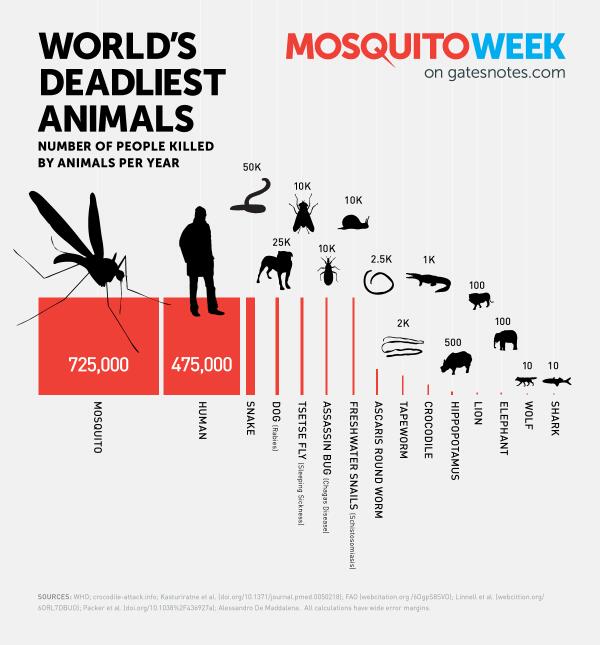Summer is in full swing across the country and Canadians from every province are enjoying our favourite summer activities: swimming, hiking, camping, fossil collecting and kayaking to name a few. Summer also means welcoming back the 85 or so mosquito species that have been peacefully hibernating in Canada over winter. Luckily, not all of these mosquitoes will bite you. In fact, only about 60 species of the 85 drink blood and only female mosquitoes carrying eggs will bite, while males and other species are happy to feast on nectar and other plant sources.
More than Just Annoying
Although mosquitoes may seem to be just a minor annoyance during your summer getaway, they are actually the most deadly animal in the world and are responsible for the deaths of roughly 725,000 people every year. Mosquitoes reach this wild level of lethality by being vectors of several deadly diseases including malaria, encephalitis, elephantiasis, yellow fever, dengue fever, West Nile virus, Zika virus and many others. Looking at this graphic below from Bill Gate’s blog, you can see that several of the most dangerous animals are smaller than the size of a quarter.

In Canada, we are lucky that a majority of mosquitoes found here are not vectors of deadly diseases. However, that does not mean that the mosquitoes here are not deadly, but that death usually comes in a different form: animal-vehicle collisions. Large animals including moose, deer, elk and bears are constantly harassed by mosquitoes, which often results in animals running onto the road to escape being bitten in heavily wooded areas near highways. These collisions happen in Canada year-round, with 70% happening between May and October so please use care and attention when highway driving, particularly at dawn and dusk.


The Worst of the Worst
There are many mosquito species and a few are particularly lethal:
1. Culex pipiens
Other Names: Common House Mosquito
Found: Americas, Europe, Asia, Africa
Carries: Japanese Encephalitis, Meningitis, West Nile Virus
Fact: There is a subspecies of this mosquito called the London Underground Mosquito (Culex pipiens molestus) that has adapted traits suited for living in subway systems ( it doesn’t hibernate, is cold intolerant, breeds year-round and prefers to feed on rats, mice and humans)

2. Aedes aegypti
Other Names: Yellow Fever Mosquito
Native to: Africa
Invaded: Americas, Europe, Asia, Australia
Carries: Yellow Fever, Dengue Fever, Chikununya Fever, Zika Virus
Fact: A. aegypti is the one of the most widespread species of mosquito, and its distribution is growing.

3. Anopheles gambiae
Other Names: African Malaria Mosquito
Native to: Africa and Madagascar
Invaded: South America
Carries: Malaria (Plasmodium falciparum)
Fact: Ae. gambiae is one of the most efficient vectors, and carries the most dangerous species of malaria.

4. Aedes albopictus
Other Names: Asian Tiger Mosquito
Native to: Southeast Asia
Invaded: Americas, Europe, the Caribbean, Africa, Middle East
Carries: Yellow Fever, Dengue Fever, Chikununya Fever, Filariasis
Fact: The Asian Tiger Mosquito is considered to be in the top 100 most invasive species in the world, and its distribution is predicted to more than triple in size in the next 20 years, particularly in urban areas.

Google is Fighting Mosquitoes … with Mosquitoes!
Just this month, Google’s life sciences unit called Verily has started a project called Debug Fresno to decrease the number of Aedes aegypti mosquitoes in the Fresno County area. Verily has created a mass rearing and sex-sorting process that allows them to breed millions of sterile male mosquitoes by infecting them with a bacteria called Wolbachia. This naturally occurring bacterium is transmitted to the female mosquitoes when they mate with infected males, which renders the females sterile as well. With this new automated system, Verily is able to release 1 million infected males every week, which will negatively impact the breeding of mosquitoes this year leading to lower numbers next year.
Is this an Ethical Eradication?
There are 3,500 known species of mosquitoes around the world, and most are completely harmless to humans. It is only the females from 6% of species that draw blood from humans, and of these, only half carry parasites. However, the effects from these 100 or so species puts half of the global population at risk of contracting a mosquito-borne illness.
That does mean that the other thousands of species get a bit of a bad rap, as these harmless mosquitoes are important pollinators and a food source for birds, bats, fish and frogs, which could be affected, along with other species further up and down the food chain. This issue is not a purely scientific one; there are also philosophical elements to consider. Is it acceptable to deliberately wipe out a species because they are dangerous to humans? Especially when we as humans are such a danger to so many other species. For now the question is hypothetical as this technique does not have the capability to fully eliminate the entire species, but we may have to ask ourselves this question in the coming decades as this along with other techniques are developed around the world.